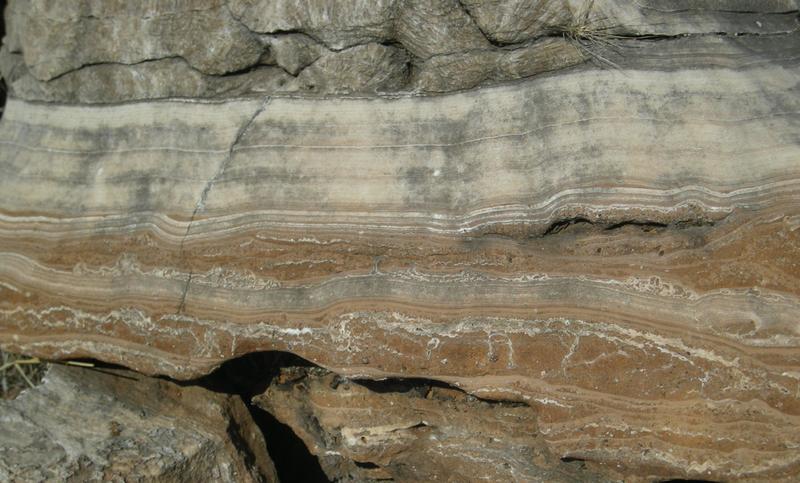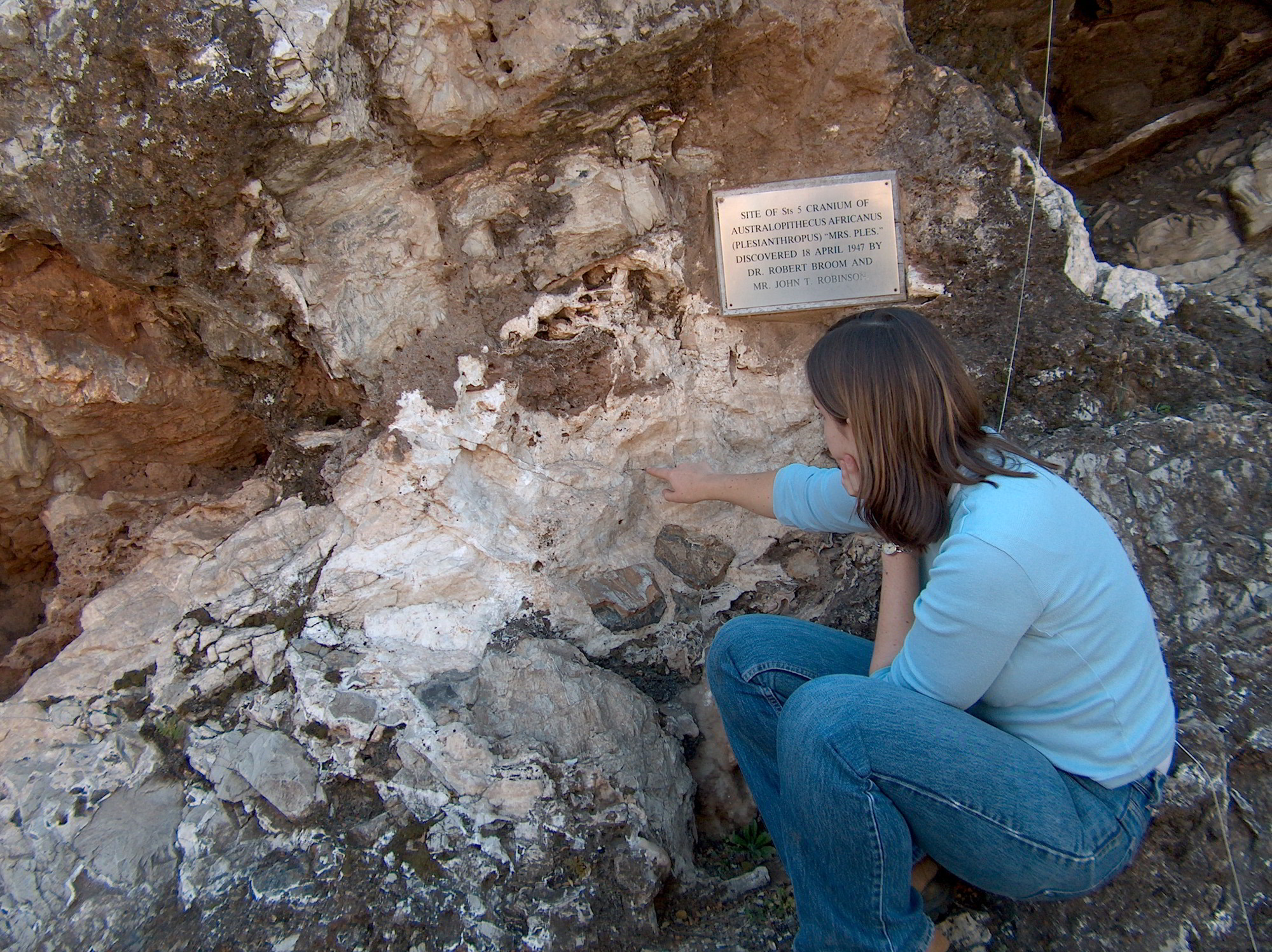Behind the paper: a new timeline of human evolution in South Africa
05 December 2018 | Story Robyn Pickering. Read time >10 min.
Our paper, published in Nature, presents the first comprehensive and direct chronology for the early human fossil sites in South Africa from the region known as the Cradle of Humankind. Most of us just call it the Cradle. We use uranium-lead dating to date the cave carbonate or flowstone layers found sandwiched between the fossil-bearing sediments to do two things. Firstly, and obviously, to date the fossils. Secondly, and less obviously, to get at what is controlling the nature and timing of cave sedimentation.
The Cradle caves are much celebrated for their complexity and have, until now, proved notoriously hard to date. Palaeoanthropology, the study of our human origins, had its birth as a discipline in South Africa, back in 1925 when Raymond Dart recognised the significance of the Taung child fossil skull and coined the name Australopithecus africanus or ‘southern ape of Africa’. The 1930s saw the rapid development of the field with Robert Broom finding numerous additional, adult fossil specimens from Sterkfontein and other cave sites in what is now the Cradle. This South African fossil record informed much of the thinking on human evolution and as such held the attention of the world.
Despite being the single richest collection of early human fossils anywhere on Earth, without ages, the South Africa record could not stand alongside the East African one.
However, as Mary and Louis Leakey began finding incredible fossils in Tanzania and Kenya, and these fossils in their rift valley setting came inter-bedded with ash layers, which could be dated, the attention began to shift away from South Africa. Despite being the single richest collection of early human fossils anywhere on Earth, without ages, the South Africa record could not stand alongside the East African one. And without ash layers in the caves, it seemed impossible that the fossils would ever be dated. Indeed, as a first-year archaeology student at the University of the Witwatersrand in Johannesburg, keenly sitting in the front row, I was taught it was impossible to date the Cradle caves.
The cave site is big and complicated and has been excavated for decades; my job was to figure out the stratigraphy of the deposits still preserved in the cave.
I grew up in Joburg and visited the Sterkfontein Caves as a little girl on a class outing. All I remember is the guide saying, “please don’t run and please don’t scream”. We all ran screaming through the caves. Years later, as a PhD student, I returned to Sterkfontein and after a few weeks of fieldwork felt like running away screaming again. The cave site is big and complicated and has been excavated for decades; my job was to figure out the stratigraphy of the deposits still preserved in the cave. I carried my field equipment (geopick, notebook, coloured pencils) around in a bucket and would spend hours sitting on my bucket staring at the rocks, willing them to tell me their secrets. This was all in order to collect samples of the flowstones to date them with uranium-lead dating – knowing the context and how the flowstones relate to the fossils is extremely important and I was determined to do this fieldwork aspect very carefully.
Over the course of the next three years, I spent weeks and weeks at Sterkfontein, mainly sitting on my field bucket but also filling notebook after notebook with observations and sketches and collecting all the flowstone my bucket could carry. As a young woman in my mid-20s, no one took me particularly seriously, at best just ignoring me or at worst telling me my work was pointless and that we already knew how old the caves were. I used to take my Dad with me, as a field assistant and bucket carrier, and to ward off sexist comments. Somebody once assumed he was the new geologist collecting samples for dating and I was the assistant.

Back in the lab, at this stage in Switzerland at the University of Bern, my PhD supervisor, Jan Kramers and I worked on extracting and concentrating the tiny amounts of uranium and even tinier amounts of lead out of the flowstones. To cut a long long story short, we did it and I defended my PhD based on a grand total of 11 new U-Pb ages for Sterkfontein and two other nearby caves.
I then packed up my stuff, which of course by this stage included a pair of skis and moved to Australia. I am convinced I am the only person ever to fly Zurich-Johannesburg-Melbourne with a bag full of rocks and a pair of skis. Jon Woodhead in the School of Earth Sciences at the University of Melbourne and his team had published a paper in 2006 titled “U-Pb dating speleothems with MC-ICP-MS” which at that stage was the title of my thesis. I literally wept. But recovered enough to realise this was where I needed to go as a post doc.
Looking back, this was rather crazy and very ambitious but also very fun.
I loved Melbourne and had a wonderful time at Melbourne Uni. I somehow convinced both the Swiss National Science Foundation and the Australian Research Council that I should keep trying to date the early hominin sites in South Africa and spent months back in the Cradle doing fieldwork. I did a lot of this work with my colleague and friend Andy Herries, who is a co-author on this paper. We set out to document and collect as much datable flowstone from as many sites in the Cradle as possible. Looking back, this was rather crazy and very ambitious but also very fun. We wanted to see if there were regional patterns across the Cradle, the caves had always been viewed as individual sites, with their own site-specific stories. But was this really the best way to approach them?
Back in Melbourne, I raced to date as many of these new flowstones as possible before I had a baby. In my final weeks of pregnancy, I had to stand side-ways and lean up against the fume hood to take beakers off the hotplate; there is nothing quite like an ever-growing belly as a tangible deadline. I arrived back at work eight months later, shell shocked at being on my own, away from the responsibility of keeping a small human alive, but was soon happily back in the lab.
In my final weeks of pregnancy, I had to stand side-ways and lean up against the fume hood to take beakers off the hotplate; there is nothing quite like an ever-growing belly as a tangible deadline.
We then moved back to South Africa, for me to take up a lectureship at the University of Cape Town and set up my own U-series dating lab in the Department of Geological Sciences; this was my dream job. I then had another baby; a baby who did not sleep. Apparently, you get babies who do sleep, but not mine. I have spent a total of 12 months of my life trudging around and around my garden in Cape Town and the block in Melbourne with a sleeping infant strapped to my chest. Much is made of a career break and the damage it does. But for me, this time away from work and the field and the lab gave me the space to reflect. Two babies and an international move meant that I was sitting on a big set of unpublished data. I was still puzzling over this question of how the caves relate to each other and how to pull the by now pretty big collection of U-Pb ages into a single record.
Flowstones, by nature, can only grow in caves which have a positive water balance, usually achieved by increased effective precipitation outside the cave. The caves also need to be closed, as if they are open and even dust blows in the fussy flowstones will stop growing. In this way, flowstones by their presence alone, signify wetter time periods. If the flowstones represent wet times, then their absence and the presence of sediments, must represent dry times, during which caves were open and sediment and fossils were washed in. Now all the caves in the Cradle preserve flowstones and what’s more, all the caves preserve an alternating stack of flowstones and sediments. Meaning that the conditions conducive to flowstone formation have switched on and off time and time again. There must be some big climatic drivers behind these wet and dry phases; the Cradle is a small area (10 x 15 kilometres) so we should be able to see the same events preserved in all the caves at the same times.
I write this as though it was all my idea. But this idea belongs to John Hancox, my honours and master’s supervisor at the University of Witwatersrand and co-author on this paper. John’s background is in Karoo sedimentology, meaning that he approached the caves with an open mind and suggested that the flowstones were the key to unravelling the cyclic nature of the cave deposits. The fact that we could then date them was almost a bonus.
Our office had big windows across the one wall and that afternoon we drew and wrote all over them with white board markers. It looked like something out of that film ‘A Beautiful Mind’.
But I still had this big unpublished data set. My colleague and friend and office mate in Melbourne, Bence Paul, also a co-author on this paper, suggested that we use a kernel-density estimate (KDE) to sum together all the U-Pb ages for the Cradle sites. Our office had big windows across the one wall and that afternoon we drew and wrote all over them with white board markers. It looked like something out of that film ‘A Beautiful Mind’.
But Bence was onto something. The KDE curve provided the single chronology I had been after and pulled the ages together allowing us to look past the (sometimes substantial) errors on individual ages and we see, for the first time, that the caves are all part of an evolving landscape, recording the same events at the same times.
...the South African record can shrug off its mantle of undatable-ness and re-join the discussion of human evolution
The peaks of the KDE represent times when caves all over the Cradle are recording flowstones, we have up to five caves with flowstones dating to the same narrow time interval. The troughs of the KDE are the flowstone free time intervals, during which the fossil bearing sediments accumulated. This means that all the Cradle fossils date to a few, narrow, dry time intervals. The caves do not preserve long, continuous records as previously imagined. We don’t have a fossil record from the wetter times – the caves were closed, accumulating flowstone. The record begins at 3.2 million years ago and fizzles out by 1.3 million years ago. Some of the hominins survive through multiple wet phases (go Paranthropus go!), others disappear (sorry Australopithecus africanus) or are one-hit-wonders like Australopithecus sediba, who appears in just one dry interval. We can now compare the South African fossils directly with their East African cousins; the South African record can shrug off its mantle of undatable-ness and re-join the discussion of human evolution.
There is more about the implications of this work for the early hominin record from South Africa in the paper itself. This story here is about the ideas, buckets and babies behind these implications.
Dr Robyn Pickering is an isotope geochemist in the Department of Geology at UCT.










